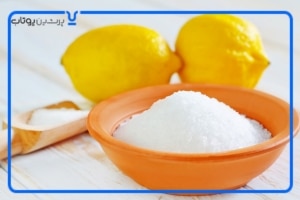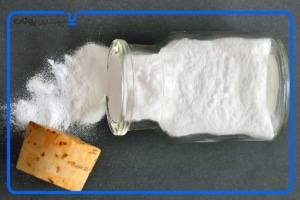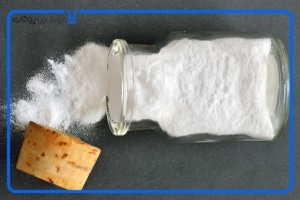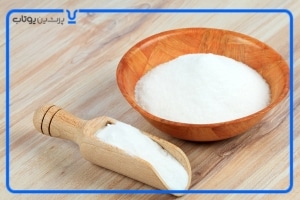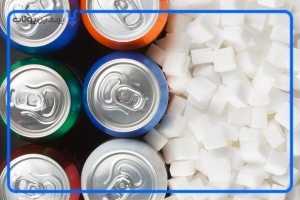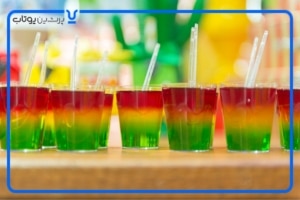TRISODIUM CITRATE
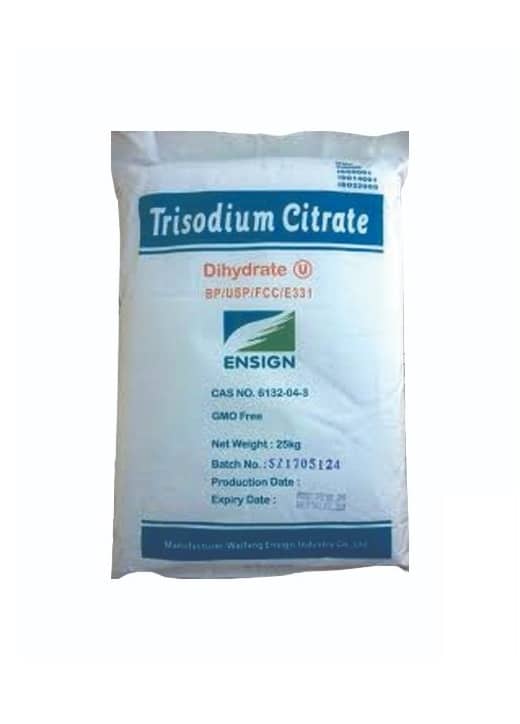
Product Information
CAS Number:
68-04-2
Chemical and physical data
Formula : Na3C6H5O7
Molar Mass: 258.6 g·mol−1
Density : 1.7 g/cm3
Melting point : 300 °C
Boiling point : 309.6 °C
Other Names
Citric acid, trisodium salt, dihydrate
1,2,3-Propanetricarboxylic acid, 2-hydroxy-, trisodium salt, dihydrate
Trisodium citrate, dihydrate
Sodium citrate, aqueous solution
Introdution
Trisodium citrate has the chemical formula of Na3C6H5O7. It is sometimes referred to simply as "sodium citrate", though sodium citrate can refer to any of the three sodium salts of citric acid. It possesses a saline, mildly tart flavor. It is mildly basic and can be used along with citric acid to make biologically compatible buffers.
Foods
Sodium citrate is chiefly used as a food additive, usually for flavor or as a preservative. Its E number is E331. Sodium citrate is employed as a flavoring agent in certain varieties of club soda. It is common as an ingredient in bratwurst, and is also used in commercial ready-to-drink beverages and drink mixes, contributing a tart flavor. It is found in gelatin mix[clarification needed], ice cream, yogurt, jams, sweets, milk powder, processed cheeses, carbonated beverages, and wine[citation needed], amongst others.
As a conjugate base of a weak acid, citrate can perform as a buffering agent or acidity regulator, resisting changes in pH. It is used to control acidity in some substances, such as gelatin desserts. It can be found in the milk minicontainers used with coffee machines. The compound is the product of antacids, such as Alka-Seltzer, when they are dissolved in water.[citation needed] The pH of a solution of 5 g/100 ml water at 25 °C is 7.5 – 9.0. It is added to many commercially packaged dairy products to control the PH impact of the gastrointestinal system of humans, mainly in processed products such as cheese and yogurt.
Sodium citrate can be used to optimize the safety and quality of snacks, cereals, bakery products and potato products such as French fries without affecting the production process.
Is sodium citrate the same as sodium bicarbonate?
Citrate is converted into bicarbonate in the body and helps correct the accumulation of acid in the blood. In addition, citrate prevents calcium deposition in the kidneys. Sodium (found in sodium bicarbonate, sodium citrate, or other sodium salts) can increase calcium levels in the blood and urine.
Why is sodium citrate used in shampoo?
Sodium citrate is added to the shampoo to keep the shampoo at the right pH level. The acidic pH interacts with the hair's slightly negative charge to help the cuticle, the outer layer of the hair, maintain a smooth surface.
What is sodium citrate used for in chewing gum?
Malic acid with sodium citrate (buffer) is used to control pH improvement against sucrose inversion in chewing gum. For example, a mixture of citric and malic acids can create a more authentic base sour flavor to enhance fruit-flavored gums.
Is sodium citrate a good electrolyte?
Sodium citrate has been shown to help increase the absorption of fluid and other electrolytes (when combined with glucose). It goes without saying that the body has the ability to absorb all sodium consumed due to its very high bioavailability.
Does lime have citrate?
The juice of one kilo of lime contains about 55.6 grams of citrate. Other types of citrus have lower citrate content. Regular consumption of lime juice can increase pH, citrate and potassium along with urine volume without increasing calcium content.
Why is sodium citrate in cream?
It is common to see disodium phosphate and sodium citrate (also known as citric acid) on ingredient labels. This safe substance acts as an emulsifier to distribute fat molecules evenly throughout the liquid so they don't stick together.
What does sodium citrate do with milk?
Under normal conditions, the citric acid content of milk disappears within two to four days. Adding citric acid or an amount equivalent to sodium citrate to milk increases the volatile acidity produced by about 50%, but does not increase the total acidity by more than 10%.
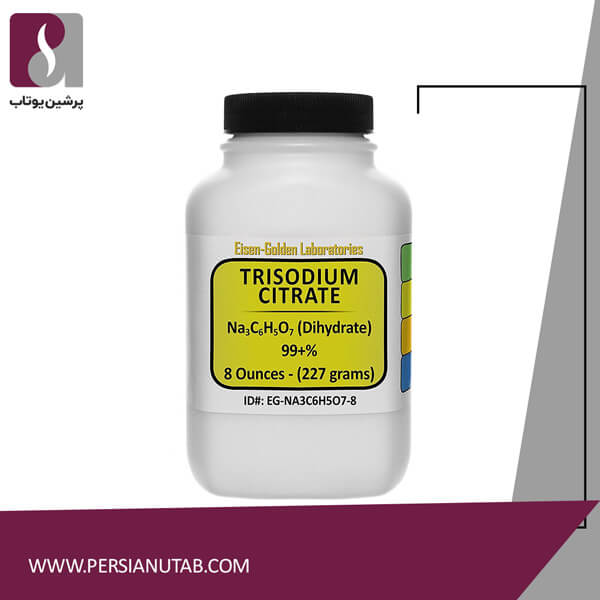
Medical uses
In 1914, the Belgian doctor Albert Hustin and the Argentine physician and researcher Luis Agote successfully used sodium citrate as an anticoagulant in blood transfusions, with Richard Lewisohn determining its correct concentration in 1915. It continues to be used today in blood-collection tubes and for the preservation of blood in blood banks. The citrate ion chelates calcium ions in the blood by forming calcium citrate complexes, disrupting the blood clotting mechanism. Recently, trisodium citrate has also been used as a locking agent in vascath and haemodialysis lines instead of heparin due to its lower risk of systemic anticoagulation.
In 2003, Ööpik et al. showed the use of sodium citrate (0.5 g/kg body weight) improved running performance over 5 km by 30 seconds.
Sodium citrate is used to relieve discomfort in urinary-tract infections, such as cystitis, to reduce the acidosis seen in distal renal tubular acidosis, and can also be used as an osmotic laxative. It is a major component of the WHO oral rehydration solution.
It is used as an antacid, especially prior to anaesthesia, for caesarian section procedures to reduce the risks associated with the aspiration of gastric contents.
Boiler descaling
Sodium citrate is a particularly effective agent for removal of carbonate scale from boilers without removing them from operation and for cleaning automobile radiators.
Sodium citrate is a buffer.
Sodium citrate is used whenever a buffering effect is required compared to pure acid (for example, acid-sensitive substances are present).
For products that are sensitive to water (for example, sodium bicarbonate in effervescent tablets), anhydrous sodium citrate can replace water-containing materials. Due to the high decomposition temperature (> 200 ° C) and low water content (<0.4%), it is also the preferred acid source in baking powder or blowers to prevent premature reaction between the acid and alkali source.
When used as a thermal blowing agent in the plastics industry, it is the preferred food and is a non-toxic alternative to exothermic blowing agents such as azo compounds (eg azodicarbonamide), hydrazine derivatives or semi-carbapsides. Sodium citrate D is used specifically in this program because of its approx. The decomposition temperature is 10 ° C lower than that of monosodium citrate F3500 and is also recommended for other applications that require faster decomposition.
Difference between sodium tri citrate and citric acid in the production process
Citric acid
It is a tricarboxylic acid that was first separated from lemon juice. In food and beverage industries, it is used for various purposes as medicine and other industrial uses. Mainly produced by fermentation of mushrooms. Chemical synthesis of citric acid is possible, but more expensive than mushroom fermentation. However, small amounts of citric acid are still produced from citrus fruits in Mexico and South America, which are economically available. Two very common and practical fermentation processes are used: liquid surface culture and immersion fermentation process. The second fermentation process is more popular.
Sodium tricitrate
Sodium tricitrate is produced by the process of neutralizing citric acid with sodium hydroxine. Obtained by fermentation of yeasts and solvent extraction. Production of sodium citrate on an industrial and mass scale is done through the fermentation process in reactor equipment. The final solution is separated by filtration and the citric acid is precipitated. It tastes sour like citric acid.
Differences between sodium triscide and citric acid in chemical structure
The chemical structure of citric acid (a triabasic acid) is HOOCCH2.C (OH) COOH.CH2COOH. Citric acid trisodium salt is commonly called sodium citrate, in which all carboxylic hydrogens are replaced by sodium.
Sodium citrate also has less moisture than citric acid, so it is less prone to cake and is preferred in vital formulations such as dry mixes, instant preparations or tablets.
How to produce trisodium citrate?
This requires baking soda and citric acid. One part of citric acid is needed for three parts of baking soda. Sodium citrate contains three sodium ions for each citric acid ion, and each baking soda molecule has one sodium atom. For example, if you want 10 grams of sodium citrate, combine 30 grams of baking soda with 10 grams of citric acid in a small amount of water. As the carbon dioxide escapes, you will see bubbles, then add a little water to the material to complete the reaction. The liquid that is finally produced has a salty taste, but it is not sour, it is a more liquid sodium-citrate.
Where to buy trisodium citrate?
If you are planning to buy trisodium citrate, you can find it in reputable health food stores called sour salt or you can buy it online.
Persian YouTube is a supplier of food raw materials including trisodium citrate.
We buy and sell our trisodium citrate from the best and most reputable manufacturers.
Conclusion
Trisodium citrate, often referred to as sodium citrate, has the chemical formula Na3C6H5 and weak acidity. The appearance of solid sodium citrate is in the form of white crystalline powder and it has a nasty taste. This substance has many applications in the food industry, which is often used to control food acidity. Another application of trisodium citrate is related to its therapeutic effects for humans. One of the most common benefits of trisodium citrate is in the human circulatory system, which prevents it from clotting.


